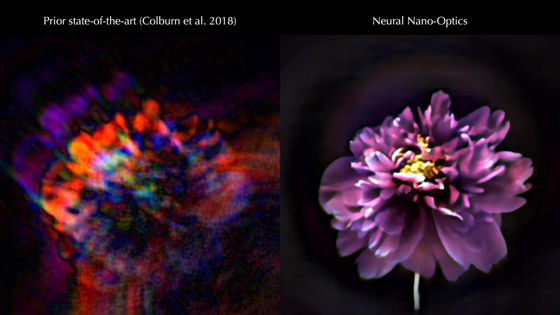'Salt grain size' camera developed with a width of only 0.5 mm

A joint research team of Princeton University and the University of Washington in the United States has developed a 'one grain size crude salt' camera with a width of only 0.5 mm. This ultra-compact camera can take pictures with the same image quality as a camera equipped with a lens with a volume of 550,000 times.
Neural nano-optics for high-quality thin lens imaging | Nature Communications
Researchers shrink camera to the size of a salt grain --Princeton University School of Engineering and Applied Science
https://engineering.princeton.edu/news/2021/11/29/researchers-shrink-camera-size-salt-grain
The new ultra-compact camera announced this time uses a technology called 'Metasurface', which is equivalent to a lens with a tiny cylinder that is almost the same size as the human immunodeficiency virus (HIV) with 1.6 million implants. Designed to work. Each of these cylinders has a different shape, and each cylinder is optimized using a machine learning-based algorithm so that it functions like a (PDF file) optical antenna. ..
Below is an image of a photo taken with a conventional ultra-small camera (left side) and a photo taken with the newly developed ultra-small camera (right side). The pictures taken with the conventional ultra-small camera have a limited viewing angle, the image itself is blurred and distorted, and the color tone is distorted, but the pictures taken with the newly developed ultra-small camera are The photos taken with a general camera are only slightly deteriorated. According to the research team, it is possible to take a picture equivalent to a camera using a lens with a volume of 550,000 times, except that the edge of the frame is slightly blurred.

It seems that this camera is innovative in that it processes the design of the optical surface and the design of the signal algorithm that generates the image in an integrated manner, and the conventional meta surface camera artificially adjusts the amount of light etc. when quality is required. It was necessary to have an ideal environment, but this meta-surface camera can demonstrate its performance even in a natural light environment. The research team says that not only can this ultra-compact camera be used for endoscopy and brain imaging, but by distributing multiple cameras on the surface of an object, new forms of photography will be possible.
Ethan Tseng of Princeton University, who participated in this study, said, 'It was very difficult to design and actually build this small structure to get the desired performance. High viewing angle RGB images. The technique of algorithmically designing millions of nanostructures for the special task of filming has never been done before. ' Shane Colburn of the University of Washington, who also participated in the research, developed a model that outputs a highly accurate approximation of the image generated by the meta surface when creating a simulator that automatically tests nano-antenna structures of different shapes. 'Since the number of nano-antennas is large and the interaction with light is complicated, the simulation required a huge amount of memory and time,' he said.
Related Posts:
in Hardware, Posted by darkhorse_log







